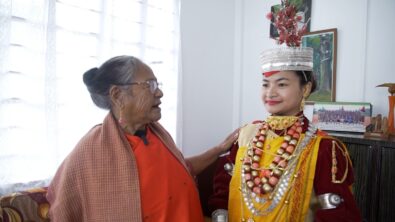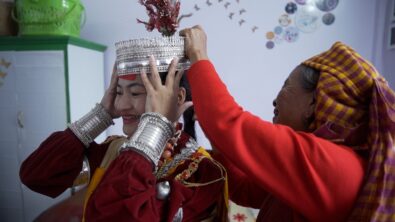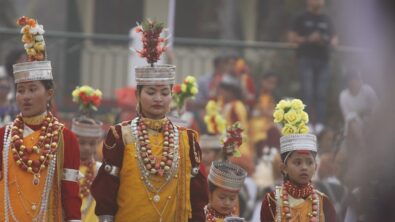
by Emma L. Buhphang
My soul soars with joy to witness the unwavering faith in the indigenous faith — Ka Niam Tynrai. IM KA NIAM, IM KA JAIT BYNRIEW (As long as our faith is intact, our identity remains true).
While the world moves at a fast pace and while different people hold different beliefs, my indigenous religious identity will continue to remain intact – Im ka Niam, Im ka Jaitbynriew – But that doesn’t mean I despise my friends or neighbours’ religion – I respect them all or as the saying goes – Burom ia ka jong kiwei, sarong ia la ka jong la jong (Respect others and be proud of your own).

I am Emma L. Buhphang and this is my story.
This is the story of my spiritual journey – a journey that has shaped my belief system, opened the treasure trove that is filled with indigenous knowledge and wisdom, and most importantly, strengthened my faith in ‘Ka Niam Tynrai’.
It wasn’t until my twenties that I felt drawn to a spiritual path, inspired by the deep faith of my grandmother and many other relatives who were actively involved in the Niam Tynrai. Their devotion truly encouraged me to explore this religious journey myself.
I must say, I was deeply enriched by listening to the wise teachings of the elders. Their words, both profound and practical, are a source of great pleasure and learning for me. Inspired by their teachings, I embrace the Niam Tynrai with respect, for its principles sustain both the belief and its people.
Apart from their teachings, the cultural festivals that we have like the ‘Shad Suk Mynsiem’ (Dance of the Joyous Soul) are another source of learning for a young enthusiast like me. Oh! What a thrilling moment it was to learn that, for the first time in my life, I would also be part of the dance – not as a spectator but as a dancer.

“To ensure our young members from the Seng Khasi Ri Raid Laban are prepared, we provide them with dance training before they participate in events at the Lympung Weiking (Weiking Ground) (sic),” said the Secretary of Synjuk ki Samla Seng Khasi Raid Laban (SKSSKRL), Budborlang Nongkynrih.
Meanwhile, SKSSKRL President Skhemborlang Kharmawplang gave a very thought-provoking remark. He said, “Should our dances cease, our beliefs fade with them; we risk becoming nothing but mere whispers in the wind – a culture erased from the earth (sic).”

A little about Shad Suk Mynsiem
Ka Shad Suk Mynsiem is an agrarian festival and celebrates the optimism for the coming year. The dance serves as a tribute to the divine, expressing gratitude for blessings and abundant harvests through symbolic rituals, traditional dances, and attire. This year, it was held from the 13th to the 15th of April.
This dance held a special significance for me this year. It was my first time joining the festivities as a dancer, taking to the grounds of the Lympung Weiking, Jaiaw.
D-Day has arrived! On the first day of Shad Suk Mynsiem, my heart was overwhelmed with joy and excitement to be a part of the festivities. And as I was getting dressed, I couldn’t help but adore and smile at my grandmothers who were busy fixing my pins, my hair, my jewelleries, etc – to make sure I looked my best.
“Turn around dear, let me have a look at you,” Meikha Jop (great paternal grandmother) whispered to me. Her dedication to gingerly dressing me in this heirloom outfit warmed my heart. That excitement and that million-dollar smile on her face while dressing me up is something I will always treasure in my heart. It’s a beautiful way to connect generations — from her daughter to her granddaughters. I was truly honoured to wear such a treasured piece. Thank you so much, Meikha Jop!

What’s in the attire?
The traditional attire of the Khasis is undoubtedly beautiful and one of the most culturally rich in the country. The overall attire carries a lot of virtue and a blessing from the Almighty.
Ka Pansngait (Crown): It signifies a virgin. The flower attached to the crown – the ‘Tiew Lasubon signifies purity.
‘Sai-Khyllong (hair buns): The three buns represent the three-corner stones of the Dpei (Hearth) and the accessories that are attached to the ‘Sai-Khyllong are indicative of the nine clans or Khyndai Trep.
Kpieng Paila (Thick coral bead gold necklace): It indicates magnificent and exquisite beauty.
Kynjri Tabah (Long silver necklace): It indicates the roles and responsibilities of a woman with implications for understanding the well-being of a family and marriage.
Mahu & Singkha (Bangles): They connect our hands and wrists to serve our purpose.
ALSO WATCH:
Kanopad (a necklace that fits closely around the neck), ‘Siar Kynthei (earings) and Kynjri Ksiar (gold ornaments): These gold jewelleries unfold the richness of the Khasi.
Ka Dhara Shad, Muka & Jain-pien (the special attire): The yellow-coloured Dhara represents gold – radiating a scintillating outlook. The Muka is the third layer of clothing and is usually worn inside the main Dhara. The Jain-pien is wrapped around the body, from the chest down till the ankle. It represents womanhood.
Ka Muhmor (A red/maroon velvet blouse): An addition to the main attire – Ka Dhara, the Muhmor is usually worn from the neck down – covering the entire neck and the hands.
“I am filled with a delightful mix of excitement and nervousness as my granddaughter embarks on this journey with such strong intentions – a true Khasi lady (sic)”, remarked my Meikha (grandmother) Kong Shortina Rynjah with a big smile on her face – an expression that melts my heart.
Adorned in my traditional attire, a strong sense of purity and vivaciousness filled the air. My expression on that day was reflective of the excitement and joy I was feeling to be a part of this delectable festival – I was about to burst into tears – tears of joy and pride.

Dancing in the Rain
The Lympung Weiking wore a bright and colourful look since Day 1. Dancers and spectators alike thronged the Weiking Ground to take part in the festivities. Fast forward to the dance, the traditional performance began with a reverent bow in prayer. This was followed by rituals and prayers, symbolizing good fortune, eventfulness, and purposeful life.
I am not going to bore you with information about the dance form because I believe many of you must have already seen and read it a couple of times.
The echoing chants (Phawar) accompanied by the drumbeats, the mesmerising tunes of the Duitara, the Tangmuri, and the cymbals filled the entire field, and one could feel the pulsating energy. Yes, my whole body grew tired from the constant movement, yet my heart was overwhelmed with joy, love, and exhilaration.
The next two days turned out quite interesting as the weather was kind enough to shower us with blessings in the form of rain. But the rain didn’t stop us from dancing – hence, we were ‘Dancing in the Rain’. Oh! It was a whole new experience and loved every moment of it.
The key takeaways
Deeply rooted in our culture and traditions, passed down through generations by the Divine and I, as a young lady, am grateful to be an intrinsic part of this community. This gratitude compels us to strengthen the very components that sustain us — our faith, our customs, and the rich tapestry of our Khasi culture.
In the spirit of Ka Niam Khasi, we must uphold love and unity – through these, we can preserve the cherished values of offering respect, esteem, and adoration.



